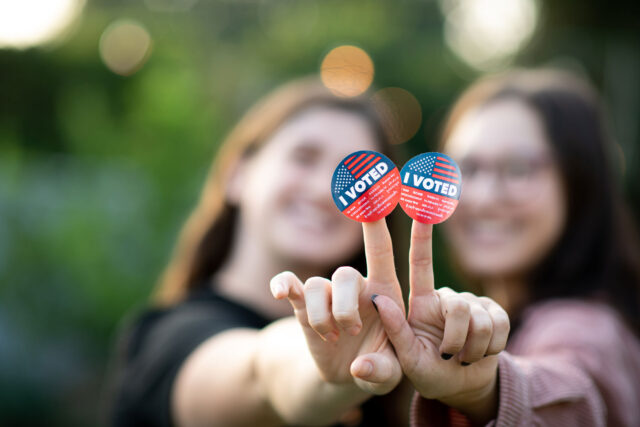Nearly half of registered voters are Democrats; independent registration has declined.
- The share of registered voters who are Democrats (46.2%) has increased slightly since 2020 (45.3%), the year of the last presidential election. The share of Republicans (24.7%) has held steady (23.9% in 2020).
- About two in ten voters (21.9%) are independents (also known as “decline to state” or “no party preference” voters); this share has declined since 2020 (25.1%). Meanwhile, the share registering with a minor political party has increased from 5.7% in 2020 to 7.2% today.
- Twenty years ago, Republicans made up a much higher share of the electorate: in October 2004, more than one in three voters (34.7%) were registered as Republicans. The share of independents (17.7%) was somewhat lower in 2004, and the Democratic share (43%) was slightly lower than it is today.
A majority of independent likely voters are ideologically moderate, compared to fewer Democrats and Republicans.
- In our surveys over the past year, independent likely voters have been equally likely to lean toward the Democratic Party (38%) or to say they do not lean toward either party (38%), while 24% lean Republican.
- Independent likely voters are far more likely to be moderate (54%) than liberal (25%) or conservative (20%). In contrast, 25% of Republican likely voters say they are moderate (73% conservative, 3% liberal) and 30% of Democratic likely voters describe themselves as moderate (62% liberal, 8% conservative).
Likely voters are disproportionately white; Democratic likely voters are relatively diverse.
- Whites make up only 38% of California’s adult population but comprise 50% of likely voters. In contrast, Latinos make up 36% of the state’s adult population but only 26% of likely voters. Asian Americans (15%) and African Americans (5%) are proportionately represented among likely voters—Asian Americans make up 16% and African Americans make up 5% of California’s adult population.
- About four in ten (43%) Democratic likely voters are white; 31% are Latino, 15% are Asian American, and 7% are African American.
- A solid majority (61%) of Republican likely voters are white; relatively few are Latino (22%), Asian American (12%), or African American (1%).
- Among independents, 54% are white, 19% are Latino, 18% are Asian American, and 4% are African American.
Six in ten Republican likely voters are older adults; a majority of Democrats are women; and half of independents are college graduates.
- About two in ten independents (22%) and Democrats (23%) are young adults (age 18 to 34), compared to somewhat fewer Republicans (15%). Meanwhile Republicans (60%) are much more likely than Democrats (46%) or independents (47%) to be age 55 and older.
- Democratic likely voters are somewhat more likely to be women (54%) than men (46%), while independents are far more likely to be men (61%) than women (39%); Republicans are more likely to be men (55%) than women (45%).
- Democrats (44%) and independents (50%) are more likely than Republicans (32%) to be college graduates; 39% of members of minor parties are college graduates. About one quarter of both Democrats (23%) and Republicans (25%) have no college education.
- About two in ten Democrats (18%), Republicans (17%), and independents (18%) have household incomes under $40,000. Majorities across partisan groups have annual incomes of $80,000 or more (57% Democrats, 58% independents, 64% Republicans), with the exception of 47% of minor party members.
Topics
2024 Election Political Landscape Statewide SurveyLearn More

Blog Post · September 9, 2024
California’s Changing Political Landscape and the 2024 Election

Fact Sheet · August 2024
California’s Likely Voters

Blog Post · July 24, 2024
Commentary: California’s Direct Democracy in Action—State Propositions on the November Ballot

Blog Post · July 9, 2024
Who Voted in the March Primary and What Does It Mean for November?

Report · March 2024
Do Registration Reforms Add New Voters or Keep Californians Registered?

Report · March 2024
The Political Views of Young Californians

Blog Post · March 26, 2024
How Has Party Voting Changed in California?

Blog Post · March 19, 2024
Discontent with Major Political Parties Continues to Simmer


